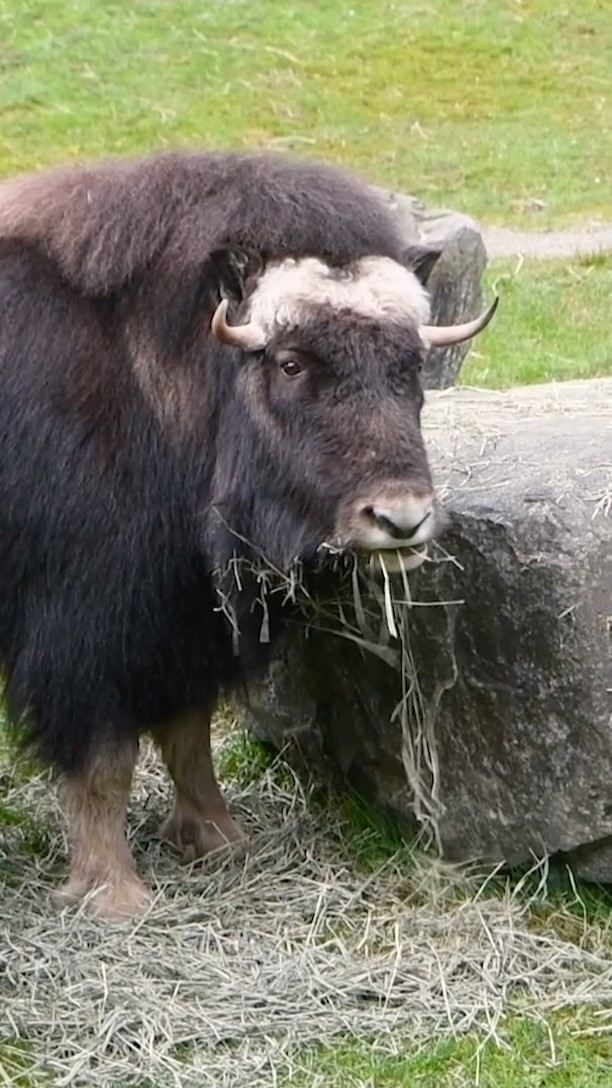- Introduction to Pretzel and Willow, two energetic young muskoxen, and their playful behaviors.
- Detailed look at the muskox species, including physical characteristics, habitat, and diet.
- Insights into the social behavior and lifecycle of muskoxen, including development stages and interaction.
- The importance of zoos in conservation efforts and the role they play in educating the public about muskoxen and similar species.
- The broader implications of preserving muskox habitat in the context of climate change and human impact.
Pretzel and Willow, two young muskoxen, are captivating attention with their lively antics in a zoological setting. Born in the spring and fall of two years ago, these youngsters are a fine example of the muskox’s power combined with youthful exuberance. Pretzel, on the verge of turning two, weighs 278 pounds, while Willow, slightly older, is a bit more robust at 341 pounds. Together, they personify the vitality of spring as they frolic energetically within their enclosure. Their joyful interactions and active play exhibit behaviors characteristic of their species, providing insights not only into their individual personalities but also into the life of the muskox in natural settings.
Muskoxen, with their long shaggy hair and strong, sturdy bodies, are native to the arctic tundra regions of Canada, Greenland, and Alaska. These animals are well adapted to one of the most inhospitable climates on Earth. Their thick coat consists of a coarse outer layer and a dense, soft underwool known as qiviut, which is one of nature’s best insulators. This natural adaptation allows muskoxen to survive temperatures that plummet well below freezing during the harsh arctic winters. In terms of physical attributes, muskoxen have cloven hooves and curved horns that aid in both defense and establishing dominance within social structures.
The natural diet of a muskox mainly consists of grasses, mosses, and lichens. During summer months, they graze on the lush arctic flora that briefly thrives in the intense light of continuous days. In stark contrast, the winter diet requires them to dig through the snow to find fibrous plants, making use of their keen sense of smell to locate buried food. This seasonal adaptability showcases their resilience and the evolutionary traits that allow them to thrive in the tundra.
Socially, muskoxen are gregarious creatures, typically forming herds of around ten to twenty individuals, although larger groupings can occasionally be seen. These herds provide various benefits, from increased vigilance against predators to communal warmth during frigid weather. Within the herd, there are complex social hierarchies managed mainly by dominant males. The young, like Pretzel and Willow, learn crucial social skills through play and interaction with peers and adults, a behavior vividly demonstrated during their zoomies through their habitat.
Zoos play a pivotal role in the conservation of muskoxen by fostering an understanding and appreciation for these remarkable animals among the public. Through carefully curated exhibits and educational programs, zoos provide experiential learning opportunities that raise awareness of the unique ecological niche muskoxen occupy and the challenges they face. Conservation efforts in zoos are critical for supporting genetic diversity and providing research opportunities that can contribute to the survival of the species in the wild.
Preserving the Muskox’s natural habitat faces serious challenges due to climate change and human encroachment. As temperatures rise, the delicate balance of the arctic ecosystem is increasingly threatened, affecting not only the availability of food but also the very landscape these animals depend on. Permafrost thaw and increased vegetation changes can alter the available resources drastically. This makes understanding the muskox behaviors, like those exhibited by Pretzel and Willow, more important than ever, as these insights can inform conservation strategies aimed at mitigating the impact of these environmental changes.
In summary, Pretzel and Willow offer more than just a spectacle of playful energy; they embody the spirit of an entire species enduring against the odds of harsh environments and evolving climates. Their antics delight zoo visitors, who, in turn, gain a deeper understanding of these arctic creatures. This facilitates a global conservation mission: to preserve not only the muskox but the crucial ecosystems they represent. Through both in-situ and ex-situ conservation efforts, the enduring legacy of species like the muskox can be secured for future generations to admire and learn from.
*****
Source Description
Pretzel and Willow are serving up some serious energy! These two playful muskoxen are making the most of a crisp spring day with some joyful romping and zoomies through their habitat. Pretzel turns two on May 5 and weighs 278 pounds. Willow turns two in September and weighs 341 pounds.


